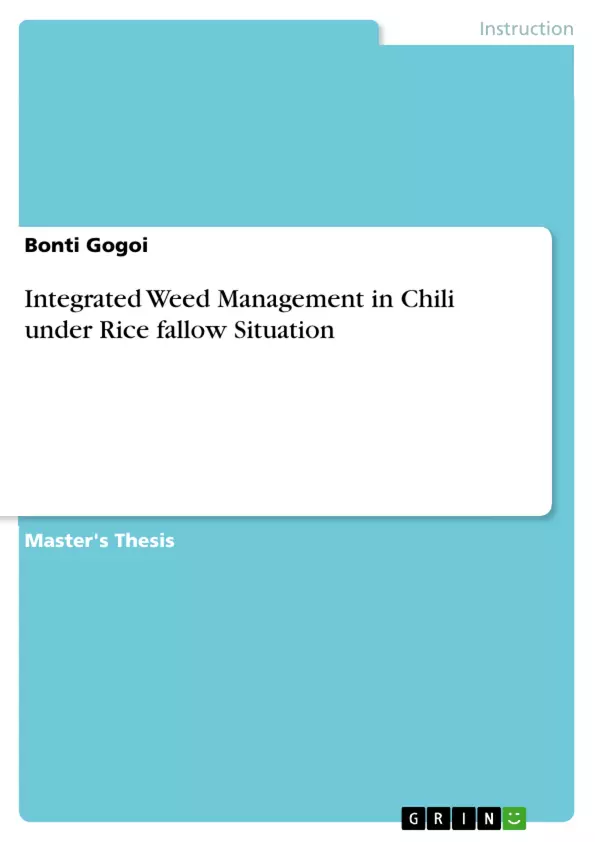A field experiment was conducted at the Instructional-cum-Research (ICR) farm of Assam Agricultural University in 2012 to study the effect of weed management practices on growth and yield of chili after winter rice. The treatments comprised of ten different weed management practices including control. The experiment was laid out in Randomized Block Design (RBD) with three replications.
The study revealed that the weed density as well as dry weight were lowest in the treatments with metribuzin @ 500 g/ha combined with garden hoeing at 30, 60 or 30, 50, 60 or 30, 60, 80 days after planting over the rest of the treatments. Among the weed management treatments, a higher weed density was observed in the three treatments of quizalofop-p-ethyl @ 50 g/ha followed by garden hoeing at 45, 75 or 60, 80 or 50, 80 days after planting. Plant height, days to 50 per cent flowering, numbers of primary and secondary branches were highest in metribuzin treated plots. Length of fruit and stalk, fruit girth, number of seeds per fruit, number of fruits per plant and yield per plant were relatively higher with treatments involving metribuzin. The fruit yield (fresh and dry) was also found to be higher in the metribuzin treated plots. Mechanical weeding with garden hoe alone closely followed metribuzin treatments in respect of fruit yield. The available nutrient was found to be lower in the plots with metribuzin treatment or mechanically weeded with only garden hoeing at different intervals. The yield loss due to uncontrolled weeds in weedy check (287 kg/ha) as compared to the highest yield (3417 kg/ha fresh chili) obtained from metribuzin 500 g/ha + garden hoeing at 30, 50 and 80 DAP was 91 per cent. The benefit-cost ratio was found to be highest ( 2.60) in metribuzin @ 500 g/ha along with garden hoeing 30, 50, 80 days after planting. The biochemical attributes like ascorbic acid (62.1 mg/100g) and capsaicin content ( ~ 60.6 mg/100g) were found to be significantly higher in metribuzin @ 500 g/ha with garden hoeing at 30 and 60 or 30, 50 and 80 days after planting over the above treatments.
From this study, it could be inferred that application of metribuzin @ 500 g/ha with garden hoeing at 30, 50, 60 days after planting controlled the weeds in chili effectively and resulted higher fruit yield, quality of chili and economic return.
Inhaltsverzeichnis (Table of Contents)
- ABSTRACT
- I INTRODUCTION
- II REVIEW OF LITERATURE
- III MATERIALS AND METHODS
- 3.1 Physico-chemical properties and available nutrients in soil before planting of chili
- 3.2 Schedule of plant protection measures
- IV EXPERIMENTAL FINDINGS
- 4.1 Weed flora associated with chili crop
- 4.2 Weed density at various days after planting of chili as affected by treatments
- 4.3 Weed dry weight at various days after planting as affected by treatments
- 4.4 Plant height at various growth stages of crop as affected by treatments
- 4.5 Number of branches per plant at 60 days after planting as affected by treatments
- 4.6 Days to flower initiation and 50 per cent flowering in chili as affected by treatments
- 4.7.1 Fruit characteristics of chili as affected by treatments
- 4.7.2 Fruit girth and number of seeds per fruit as affected by treatments
- 4.7.3 Yield attributing characters of chili as affected by treatments
- 4.7.4 Fruit yield (fresh and dry) of chili as affected by treatments
- 4.8 Biochemical parameters of chili as affected by treatments
- 4.9 Organic carbon and available nutrient content in soil after harvest of chili
- 4.10 Economics of different treatments
- V DISCUSSION
- VI SUMMARY AND CONCLUSION
Zielsetzung und Themenschwerpunkte (Objectives and Key Themes)
This research aims to investigate the effects of different weed management strategies on the growth, yield, and quality of chili pepper. The study seeks to identify the most effective weed control methods for maximizing chili production while minimizing environmental impact.
- Weed management strategies and their impact on chili growth and yield
- The influence of weed control on chili quality and biochemical parameters
- Economic feasibility of different weed management approaches
- Environmental considerations related to weed control practices
- Optimization of chili production through integrated weed management
Zusammenfassung der Kapitel (Chapter Summaries)
- Chapter I: Introduction This chapter provides an overview of chili pepper cultivation, highlighting its importance and the challenges posed by weed infestation. It sets the context for the research by discussing the significance of weed management practices in chili production.
- Chapter II: Review of Literature This chapter presents a comprehensive review of existing literature on weed ecology, weed management techniques, and their impact on chili pepper cultivation. It explores various methods of weed control, including manual weeding, herbicides, and integrated weed management approaches.
- Chapter III: Materials and Methods This chapter details the experimental design, materials used, and the methodology employed in the study. It outlines the different weed management treatments, the experimental site, and the parameters measured to assess the effects of weed control on chili pepper.
- Chapter IV: Experimental Findings This chapter presents the results of the experiment, showcasing the data collected on weed dynamics, chili growth, yield, and quality. It analyzes the impact of different weed management treatments on various parameters, providing insights into the effectiveness of each approach.
- Chapter V: Discussion This chapter interprets the findings of the experiment, drawing conclusions about the most effective weed management strategies for chili pepper cultivation. It discusses the implications of the results for sustainable chili production, considering economic, environmental, and social factors.
Schlüsselwörter (Keywords)
The study focuses on the keywords: chili pepper, weed management, integrated weed management, herbicide application, weed control, yield, quality, economic feasibility, environmental impact, and sustainable agriculture.
- Quote paper
- Bonti Gogoi (Author), 2013, Integrated Weed Management in Chili under Rice fallow Situation, Munich, GRIN Verlag, https://www.grin.com/document/350451



